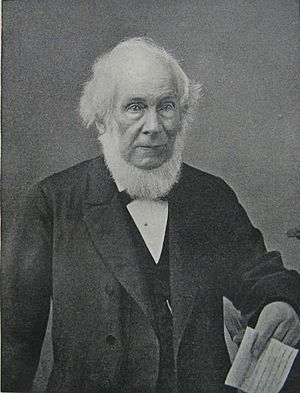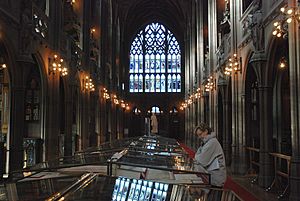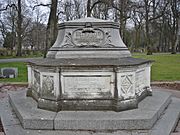John Rylands facts for kids
Quick facts for kids
John Rylands
|
|
|---|---|
 |
|
| Born | 7 February 1801 Parr, St Helens, Lancashire, England
|
| Died | 11 December 1888 (aged 87) Stretford, Lancashire, England
|
| Nationality | British |
| Occupation | Engineer |
| Spouse(s) | Dinah Raby, Martha Carden, Enriqueta Tennant |
| Parent(s) | Joseph Rylands and Elizabeth (née) Pilkington |
John Rylands (born February 7, 1801 – died December 11, 1888) was a British businessman and generous giver. He owned the biggest textile company in the United Kingdom. He was also Manchester's first person to become a multi-millionaire.
John Rylands learned how to weave cloth. Then, he started a small business making hand-looms. He also worked in his father's fabric shop in St Helens. He was very smart at selling things, even when he was young. He teamed up with his two older brothers to sell goods to other businesses. They were so good that in 1819, John's father joined them. They created a company called Rylands & Sons. At its best, the company had 15,000 workers in 17 mills and factories. They made 35 tons of cloth every day!
The Life of John Rylands

John Rylands was the third son of Joseph Rylands, who made cotton goods in St Helens, Lancashire. His mother was Elizabeth Pilkington. John went to Grammar School in St Helens.
He was very good at business from a young age. Before he was 18, he joined his older brothers, Joseph and Richard, in their business. Their father joined them in 1819, and they formed Rylands & Sons. Their main office was in Wigan. For many years, they made fabrics like ginghams, checks, and calicoes.
John, the youngest partner, traveled to many places to get orders until 1823. That year, he opened a warehouse for the company in Manchester. Their business grew very fast. In a few years, they bought many properties in Wigan, including places to dye and bleach fabrics. Later, they found valuable coal under these properties, which made them even richer.
In 1825, the company started selling goods from other makers, not just their own. Around the same time, they built a new cotton spinning mill. They later bought more factories, including the Ainsworth mills near Bolton.
Joseph and Richard retired around 1839. When their father died in 1847, John Rylands became the only owner of the business. The company kept growing. In 1849, they opened a warehouse in Wood Street, London.
In 1854, a big fire happened at their Manchester warehouse. Even though the loss was huge, they quickly rebuilt it. By 1864, their warehouses in Manchester were seven stories tall. They stretched all along New High Street (now High Street). These warehouses became the most important part of the company.
In 1873, Rylands changed his business into a limited company. This meant it could raise more money from investors. But he still managed everything himself. With more money, they bought more mills. The company started new business in many parts of the globe. With £2 million in capital, his company became the biggest textile maker in the UK. His business made him Manchester's first multi-millionaire. He had 15,000 employees in 17 mills and factories. They produced 35 tons of cloth every day.
From 1857, John Rylands lived at Longford Hall in Stretford. This was a grand Italianate mansion he built. In 2009, the local council put a "blue plaque" at Longford Hall. This plaque remembers John and his wife Enriqueta Rylands.
Helping Others and Public Works
John Rylands was a quiet person, except when he was with friends. He never wanted to hold public office, but he cared about public interests. He supported new ideas and projects. When the Manchester Ship Canal was being planned, and there wasn't enough money, he bought £50,000 worth of shares. He gave even more when the project was in trouble again.
Rylands was a Congregationalist, which is a type of Christian faith. He also liked the Baptist faith. He believed that different Christian groups should work together. He supported several Union Chapels, including one in Stretford and two in Manchester. He gave a lot to charity, but he did it quietly.
Among his many good deeds, he started and supported:
- orphanages (homes for children without parents)
- Homes for older gentlewomen
- A rest home for Christian ministers who didn't have much money
- A town hall, public baths, a library, and a coffeehouse in Stretford, where he lived.
He also built an institute for the people of Havenstreet on the Isle of Wight. Rylands spent some of his later years there after 1882. He built a house there called Longford, named after his home on the mainland. He gave so much money to the poor in Rome that the king of Italy gave him an award in 1880. It was called the Order of the Crown of Italy.
For many years, he hired scholars to create special editions of the Bible and religious books. He printed these books to give away for free. Some of these included:
- The Holy Bible, arranged in numbered paragraphs, 1863.
- Diodati's Italian Testament, for people in Italy.
- Ostervald's French Testament, also arranged in a similar way.
- Hymns of the Church Universal, a selection from 60,000 hymns he collected.
Family and Legacy
John Rylands married three times. His first wife was Dinah Raby in 1825. They had six children, but sadly, none of them lived longer than him. In 1848, he married Martha Carden. In 1875, he married Enriqueta Augustina Tennant.
After John Rylands died, his widow, Enriqueta, built a special library in Manchester to remember him. This is the famous John Rylands Library. She bought many valuable books for it, including the Althorp Library from Earl Spencer in 1892. She also bought Lord Crawford's old manuscripts in 1901. The library opened on October 6, 1899. On that day, Mrs. Rylands received the Freedom of the City of Manchester, a special honor. The library officially opened to the public on January 1, 1900.
John Rylands passed away at his home, Longford Hall, on December 11, 1888. He was 87 years old. He was buried in the Southern Cemetery, Manchester. A beautiful tomb was built over his burial place. His widow was buried there in 1908. The tomb was designed by C. H. Heathcote and finished in 1892. The fancy top part of the tomb, which had four angels, was removed in 1927 after it was damaged. The bronze railings were stolen in 1967.
The tomb has several Bible verses carved on it. These verses show his strong Christian faith:
- "Redeemed with the precious blood of Christ." (1 Peter 1:18-19)
- "They shall be mine saith the Lord of Hosts In that day when I make up my jewels." (Malachi 3:17)
- "Looking for the mercy of our Lord Jesus Christ unto eternal life." (Jude 1:21)
- "Kept by the power of God through faith unto salvation." (1 Peter 1:5)
- "The Lord stood with me and strengthened me." (2 Timothy 4:17).
- "Not slothful in business, fervent in spirit serving the Lord." (Romans 12:11).
Most of his money was left to his wife, Enriqueta. His estate was worth £2,574,922. This was more money than any other cotton manufacturer had left behind at that time.
Images for kids





